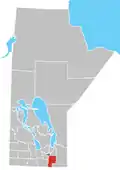Richer, Manitoba
Richer is an unincorporated community recognized as a local urban district[1] in southeast Manitoba, almost 60 kilometres (37 mi) east south-east of Winnipeg.[2] It is located in the Rural Municipality of Ste. Anne, at the junction of the Trans-Canada Highway and Provincial Road 302.
History
Richer, originally called Coteau-de-Chênes, was then renamed Thibaultville in 1901. It was then named for H. Isaïe Richer who was the first postmaster and was a philanthropist and benefactor in the region. During the winter of 1861 and 1862 lumber was collected from this area for the construction of the third cathedral at Saint Boniface. The construction of the Dawson Road in 1869 led to an influx of Metis moving to Côteau-de-Chênes to work on road construction joining the Métis inhabitants who had been settled in the area for several years. Father Alexandre Defoy came to work as a missionary in the region and in 1903 he became the first resident priest in the mission of Thibaultville where he built a first chapel on a land donated by Pierre Michaud. In 1904, Bishop Louis-Philippe-Adélard Langevin, Archbishop of Saint-Boniface, erected the mission of the Enfant-Jésus to Thibaultville and named Father Defoy the first parish priest.[3] Located on the historic Dawson Trail, Richer is rich in early Canadian history French-Canadian, English Canadian as well as Aboriginal and Metis peoples. There is a strong spirit of pride in the community's past and connection with the explorers who built the 850 km Dawson Trail that winds its way through Lorette, Dufresne, Ste. Anne as well as Richer and continues eastward all the way to the Whitemouth River and beyond.
Services
The local Richer School currently has about 150 students, ranging from kindergarten to grade eight. Richer School is part of the Seine River School Division.
Richer also has one of the few wooden Catholic Churches that are more than a hundred years old. The church has been converted to the Dawson Trail Museum and features displays and artifacts depicting the rich history of the region.
Recreation
Richer has three nearby campgrounds: the Rock Garden Campground, Cripple Creek Campground, and the Wild Oaks Campground.
Dawson Trail Park boasts two baseball diamonds, an outdoor skating rink, picnic shelter, a rodeo/riding arena and new and improved playground.
The Mockingjay Pole Archery Club shoots in the park from May until September.
Richer Rough Stock Rodeo takes place every second weekend of August. The Richer Rodeo won Heartland Rodeo's Rodeo of the Year in 2013, 2014, 2016 and 2017.
Winterfest occurring at the end of February or beginning of March.
Each summer the Dawson Trail Museum features an indoor and outdoor farmers market. In the spring and fall they host an Artisan Craft Sale featuring local Crafts and Baking.
Business
Dawson Trail Dispatch is the local newspaper located in Richer. The Dawson Trail Dispatch brings coverage of southeastern Manitoba local news. There is also Burnell’s, a general store, a post office, a number of restaurants, a hotel and a gas station. The Richer Community Club Inc. produces a monthly newsletter called the EnRicher keeping the local residents of the area informed of events and news.
Notable people
Cynthia J. Faryon is an internationally published author who resides in Richer. Faryon focuses her writing on Canadian content with topics on travel, family issues, biography, and history. One of her well-known works has been Unsung Heroes of the Royal Canadian Navy: Incredible Tales of Courage and Daring During World War II.[4]
References
- "Local Urban Districts Regulation". Government of Manitoba. April 23, 2016. Retrieved April 24, 2016.
- https://www.google.com/?client=safari#q=Richer+manitoba+to+Winnipeg,+Manitoba
- Barkwell, Lawrence J. (2018) Historic Metis settlements in Manitoba and geographical place names. Winnipeg, Manitoba: Louis Riel Institute, 2018. ISBN 978-1-927531-1-81
- Cynthia J. Faryon. Goodreads. Retrieved 14 April 2012.
